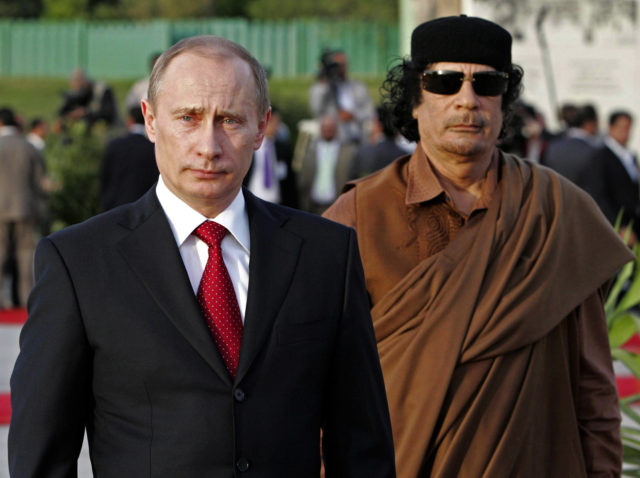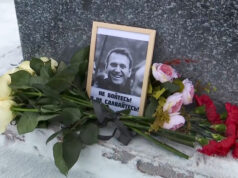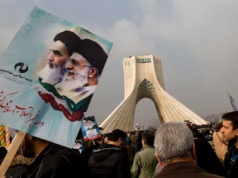
Why was 2012 a turning point for Russia’s presence in the Middle East? Because this was the point of transition in Moscow’s post-Soviet regional posture. After 2012, Russia’s leadership adopted a more strategic approach to the Middle East by seeing it as a region of growing importance for achieving the Kremlin’s political goals. This period witnessed the return of Russian diplomacy to the Middle East and early reestablishment of the country as an important regional player. This status had been lost by Moscow after the fall of the Soviet Union in 1991. Yet, there is still no unanimity among scholars and policy analysts regarding the origins of this transformation in Moscow’s vision of the Middle East and the region’s priority within the framework of Russian strategic thinking.
Conflict with the West
Formally, the increased frequency of Russian contact with the Middle East since 2012 is connected to overall diplomatic changes caused by the Kremlin’s confrontation with the United States and European Union. As a result of these tensions, Moscow had to try to shift its orientation from the West, which had been a key focus of Russian diplomacy in 1991-2012, to non-European countries including in the Middle East. Addressing the Russian Federal Assembly on Dec. 4, 2014, President Vladimir Putin declared cooperation with the countries of the Middle East as one of the priorities of Russian diplomacy, and on Feb. 27, 2015, Foreign Minister Sergei Lavrov argued that “the turn to Asia” (which in Russian traditional understanding includes the Middle East) reflects long-standing national interests in the 21st century.
In reality, the situation appears to be more complicated. Indeed, the current rapprochement between Russia and the countries of the Middle East was mainly determined by Moscow’s relations with the West. Russia’s active policy toward the Middle East and Asia is aimed at the creation of leverage that can help it to affect the behavior of the United States and European Union and to mitigate the negative effects of confrontation with the West on the economy, security, and international relations of Russia. Between 2012 and 2017, new tensions with America and EU countries, first over Syria and then over Ukraine, impelled the Kremlin to intensify its Middle Eastern contacts.
However, there are considerable differences between the current situation and previous Russian attempts to build close relations in the Middle East. This difference is largely determined by the scale and intensity of Russia’s conflict with the European Union and United States, which is more intense than at any time since the fall of the USSR.
To cope with the political and economic challenges caused by existing tensions with the West, Russia was compelled to adopt a more nuanced approach to the Middle East than previously required. In the past, the goal was just the creation of leverage that could be used to affect U.S. behavior or win additional concessions from it.
Now, the complexity of tensions with the United States and the European Union compels Russia to set multiple priorities for the region. Russia has had to revise its previous vision of the region as just a part of a global chessboard that is defined above all by Russia’s relations with the West. The new approach is not a result of a full break with the past but a product of the transformation of the old policy that still places the Middle East within overall Russia strategy. However, it also now treats the Middle Eastern countries more in terms of what direct, bilateral benefits they bring to Russia, sometimes separate from the issue of relations with the West.
Putin and the Middle East
Another factor determining the depth of the Russian foreign policy transformation in the Middle East is the personality of the country’s leader. The current policy makers believe Russia, as a country lying between Europe and Asia, should diversify its political and economic diplomacy that—in their view—had been excessively concentrated on the West since 1991. President Vladimir Putin’s vision contrasts with Russian views on the Middle East under Boris Yeltsin (1991–1999) and Dmitry Medvedev (2008–2012). The latter two considered the Middle East to be of secondary importance to Kremlin diplomacy.
This difference between Putin and Medvedev-Yeltsin’s perceptions of the Middle East was clearly demonstrated by the controversy over the Libyan crisis of 2011. While Putin labeled the United States and European Union as “new crusaders,” Medvedev expressed his satisfaction over the news of Muammar Qaddafi’s capture. These differing reactions nearly led to a split in the Putin-Medvedev tandem.
It was therefore no surprise that, immediately after his return to the presidency in 2012, Putin began restoring relations with the Middle East, which had been seriously damaged under Medvedev. Thus, only two months after his election Putin met his Iranian counterpart, Mahmoud Ahmadinejad. During that meeting he stated his interest in the further development of relations with Iran, calling it “an old traditional partner.”
The Putin of 2012 was also different from the Putin of 2000 and 2004: more authoritarian, more decisive, more anti-Western and extremely disappointed by the failure of the “reset” in Russian-U.S. relations. This could not but affect Russia’s stance on the Middle East. At least initially, the support provided to Bashar al-Asad’s regime was, in fact, revenge for political and economic losses in Libya and Iraq. Russia was among the first countries to cut military supplies to the Qaddafi regime; it also refrained from vetoing the UN Security Council resolution that paved the way for Western military intervention in the Libyan conflict. Russian leadership was frustrated that its silent support for the West in Libya did not receive acknowledgment in Washington or Brussels. This contributed to its decision to be more of a spoiler if its positions on global affairs were not acceded to by Western states.
Russian Realities
The domestic situation in Russia also favored changes in policy in the Middle East. Public discontent with Medvedev’s government and controversy over Putin’s re-election in 2012 compelled the leadership to shore up its support. From 2012, official propaganda started to appeal more aggressively to nationalistic sentiments of the population. These appeals received a positive response. A large proportion of the Russian population wished to see Medvedev’s successor more actively protecting their perceived national interests and cementing relations with the non-Western powers. Putin gave them what they wanted. Russian support for Damascus, closer relations with Tehran, and rapprochement with Cairo were supposed to symbolize a return to the old traditions of the Soviet empire for those missing the “imperial” glory of the USSR. Prior to its fall in 1991, the USSR had close political and economic relations with all these countries.
After the return of Putin to his presidential seat in 2012, Russian communications media started periodically explaining international realities via the prism of the Middle East. Thus, during the active military actions in Ukraine’s Donbas area in 2014-2015, Moscow’s propaganda argued against the effectiveness of Western military assistance provided to Kiev by addressing the West’s experience in Iraq. It was pointing out that American arms and instructors did not help the Iraqi army to stand up to ISIS.
Propaganda and Moscow’s Foreign Policy
When covering Middle Eastern issues for a domestic audience, Russian politicians and the news media make bold and emotional statements with only rare attempts to restrain themselves. That is largely determined by a need to keep the public in a certain political frame of mind and constantly oriented to a set of basic ideas. For instance, in his interview with the Russian media on Apr. 22, 2015, Foreign Minister Sergey Lavrov openly accused Washington of being responsible for creation of al-Qaeda and the Islamic State, first by supporting the mujaheddin (holy warriors) in Afghanistan in the 1980s and then invading Iraq in the 2000s. Some pro-government analysts and journalists go even further. They exploit the traditional belief of the Russian population in conspiracy theories by spreading myths about the deliberate destabilization of the Middle East by America after the Sept. 11, 2001 al-Qaeda terrorist attacks and the absence of a real American interest in stopping the bloodshed in Syria and Iraq.
However, a liar eventually starts to believe in his own lies. Russian propaganda was not an exceptional case. From this point of view, the official discourse on Middle Eastern events in Russia may have a negative outcome for Moscow. Officials have already started to believe in some propagandistic statements as the truth. This over-simplifies analyses and leads to a misperception of the situation. For a long time, all Syrian rebels using Islam as an ideology to mobilize people for struggle were believed to be religious extremists (only in September 2015 did Moscow start to differentiate between moderate Islamists and the radicals). Meanwhile, the IS connection is suspected behind any terrorist activity in Russia or the post-Soviet space of former satellites and Soviet republics.
From this point of view, Russian propaganda is a factor that promotes Moscow’s greater involvement in the Middle East. Currently, the Russian authorities believe that there was no option other than Russian military deployment in Syria. The Kremlin also trusts that Russia can effectively affect the development of events in the region and even challenge Western plans. Thus, when presenting the failure of the Obama administration to organize a military operation against Asad in 2013 as the result of Russian diplomatic efforts rather than the indecisiveness of Washington, Moscow began to imagine that it could offset any U.S. and EU plans in the Middle East. This, in turn, encouraged Russia’s further involvement in Syria and the above-mentioned experiments in Libya.
Arab Spring as Kremlin’s Nightmare
Finally, Putin’s intention to strengthen Russian relations with Middle Eastern countries was seriously fortified by the results of the Arab Spring of 2011–12. Initially, Russia ignored the uprisings, considering them minor turmoil unlikely to bring structural change. Even the fall of Egyptian President Hosni Mubarak did not make Russian authorities reconsider. Russia “woke up” only after the killing of Qaddafi in October 2011. Trying to explain why the Middle Eastern political system that seemed to be relatively stable for the last 20 to 30 years was accidently and unexpectedly destabilized by a chain of uprisings none could predict, Moscow retreated to its traditional narrative of “color revolutions” (as in Georgia in 2003, Ukraine in 2004, and Kyrgyzstan in 2005). This theory accuses the West of attempting to destabilize the international system with (anti-authoritarian) revolutions and to impose its “improper” democratic values on other nations.
Considering the Arab Spring at least partially an American and EU plot, the Russian government felt it had no choice but to become more deeply involved to balance the “destabilization” of the political situation in the Middle East by Western powers to prevent repercussions in Eurasia. However, the Arab Spring also had an effect on Russian strategic thinking in the Middle East that had nothing to do with either Moscow’s concerns regarding potential anti-regime uprisings in Russia or its confrontation with the West.
Losing Ground
In 2012, the Kremlin realized that it was very close to losing its political and economic presence in the Middle East for the long run as a consequence of the popular Arab uprisings coupled with its vision of the region as an area of secondary importance for Russian geostrategic goals. Indeed, during the Arab Spring, Moscow sustained heavy economic losses the real quantity of which is still to be determined. Russian arms exporter Rosoboronexport estimates its financial losses in Libya after the fall of Qaddafi at $2 billion to $6.5 billion. The Russian railway corporation RZD was another victim of the Arab Spring in Libya. Its immediate losses were estimated at $2.2 billion. Given that RZD planned to work with Qaddafi’s government for many decades to come the amount of lost potential profit could be even higher. Finally, in April 2008, Moscow forgave $4.5 billion of Qaddafi’s debts to the Soviet Union in exchange for the involvement of Russian companies in new joint projects in Libya. Russian oil and gas companies, such as Gazprom, Lukoil Overseas and Tatneft either were involved or planned to invest in the energy sector in Libya. Apart from the economic losses inflicted by the fall of Qaddafi, the beginning of the civil war in Syria also endangered Russian investments in that country.
Political losses from the Arab Spring were also quite high. First, the fall of Moscow’s old partners such as Qaddafi fundamentally clouded the future of Russian relations with the countries previously headed by these dictators.
Second, the Arab Spring hampered the development of Russian relations with those countries whose governments had become interested in the establishment of closer political and economic ties with Moscow in the 2000s. The members of the Gulf Cooperation Council (GCC) represent the most notorious example. Russian support for Syria’s Bashar al-Asad diverted GCC countries (Saudi Arabia, Kuwait, Oman, Qatar, Bahrain, and the United Arab Emirates) from Moscow. After 2011, it took about two years before Russia could finally resume effective discussion of bilateral, regional, and international issues with Saudi Arabia and Qatar.
Third, the Arab Spring presented a serious threat to the dialogue between Russian authorities and the religious leaders of the Middle East. Russian support of Asad’s Alawite [Editor: heterodox Shiite] regime caused criticism from the Sunni Muslim-led GCC states. Meanwhile, the development of positive relations with these countries traditionally has been seen by Moscow as one factor directly influencing its own the political stability. Russian authorities have believed that until the majority of Sunni Muslim religious leaders consider the situation of the Russia’s southern Muslim minority population as normal, limiting outside moral and financial assistance to radical Islamists in southern Russia would be difficult.
Time to Be Active
These losses were hard to explain by invoking the Western plot theory. Moreover, they clearly demonstrated that the Middle East itself was important for Russia and it was high time for Moscow to reject the old approach when relations with the region were used only as a trading item in bargaining in its relations with the West. In a certain way, Libya was a turning point. On March 17, 2011, the Russian government did not veto U.N. Security Council Resolution 1973, which paved the way for the U.S. and EU intervention in Libya. Subsequently, Russia imposed sanctions on Libya and it was the first to stop arms exports to the regime of Qaddafi.
In the eyes of the pro-Western grouping of Russian ruling elite these steps were worth making. In 2011, Moscow still hoped to reset relations with Washington, and military contracts with France also played their role. Nevertheless, this time the losses did not justify gains. Medvedev’s decisions on Libya probably determined the destiny of Qaddafi. In other words, previously, Russia only cheated on its Middle Eastern partners whereas in 2011 it betrayed the previously friendly regime of Qaddafi also.
Under these conditions, the image of Russia in the Middle East suffered heavily. According to traditions of the region, treachery (no matter who the betrayed person is) is never forgotten. Treachery also is considered a sign of weakness. So is the strategy of balancing between different forces; a strong player can afford to clearly demonstrate his preferences. This, in turn, assured the opponents of Russia in the region that in other cases the opinion of Moscow could be ignored. Consequently, Moscow had to reassess its approaches to the Middle East.
Russian losses clearly demonstrated that, apart from the dynamics of Kremlin’s relations with the West there are at least two groups of factors that also determine the necessity of Moscow’s presence in the Middle East: Russian economic and security interests. The fact that, after 2012, these factors acquired greater importance in Moscow’s decision-making on the region was another reason for determining the depth of the transformation of Russian approaches to the Middle East.
Nikolay Kozhanov, Ph.D., is Visiting Lecturer at the European University in St. Petersburg, Russia, and Academy Associate, Russia and Eurasia Program, Chatham House, London, England.





